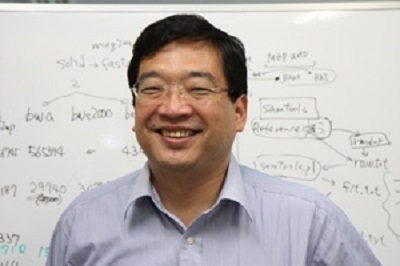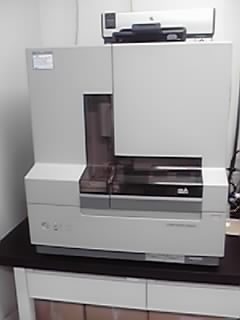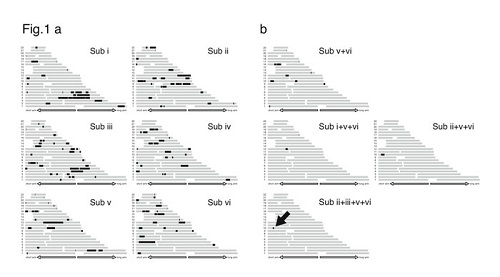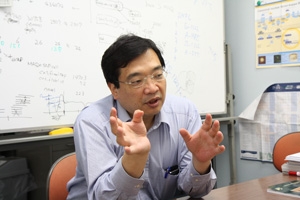Discovering the Causal Gene of Amyotrophic Lateral Sclerosis (ALS)!: Detecting a Mutation Focusing on Recessively Inherited ALS

We talked to Professor Hideshi Kawakami, Department of Epidemiology, Division of Radiation Bio-Medical Informatics, Research Institute for Radiation Biology and Medicine.
(May 25th, 2010, Interviewed by Public Relations Group, the Community Collaboration and Information Policy Office)
Profile
Immediately after his graduation from the Department of Medicine, Faculty of Medicine, Hiroshima University in 1984, Professor Kawakami entered the Graduate School of Medicine at Kyoto University to study hormones under Professor Shigetada Nakanishi.
In 1979, Professor Nakanishi (at that time an assistance professor) was using a brand-new gene analysis technology just developed in the USA for determining the structure of a “precursor” protein, which produces an adrenocortical stimulating hormone. Afterward, Professor Nakanishi became the first scientist in the world to succeed in synthesizing a precursor within a test-tube, and he was also one of the worldwide leading scientists famous for determining the structure of proteins from gene information.
Professor Kawakami, who hoped to figure out the etiology of incurable diseases such as Huntington disease, Muscular dystrophy, etc. by genetic methods, decided: Let’s study neurological molecular biology! After working at Kyoto University Hospital, he came to Hiroshima University in 1992. He has been consistently involved in the research of Neurology ever since.
Do what must be done!
The research of degenerative neurological disorders causing the death of special neurons within the central nervous system such as Parkinson Disease, Alzheimer Disease, Huntington Disease, Spinocerebellar Degeneration etc. , has already progressed rapidly.
“It doesn’t make sense to do research on something that is already almost cleared up. But there is still Amyotrophic Lateral Sclerosis (ALS), a degenerative neurological disorder of unexplained origin. ALS research is absolutely necessary to develop an effective treatment. Let’s do it!”
A disease of still unexplained origin
There are about 8000 ALS patients in Japan. Every year one person out of 100,000 develops ALS. ALS patients are hit with a debilitating feeling of exhaustion, breathing problems and would die within 2-5 years without the assistance of an artificial respirator. An abnormity of the motor neuron diminishes the volume and strength of the muscle. The origin of ALS has no relation to the muscles themselves. Also, genes are not the main cause of ALS. Not more than 10% of the cases occur on a hereditary basis, and the disease causing gene itself was found in only 20-30% of the cases. There are a lot of questions that remain unanswered.
Narrow down the target and go ahead!
The technological progress of cutting-edge testing equipment is spectacular, but although the DNA sequencing of the human genome was easily accomplished, it takes too much time and costs too much money to randomly analyze the huge quantities of genetic information from a large number of patients. To analyze the genetic information (base sequence) of even only one individual, it takes 10 days and costs about 5,000,000 Yen.

Fluorescence sequencer for decoding and analyzing DNA sequences. A new generation of sequencers has been developed and while this equipment is quite archaic, it is still very important.
Consequently, Professor Kawakami and his research group decided to focus on recessive inherited ALS, a disease which originates in a chromosomal abnormity in both parents. In the case of autosomal recessive inheritance the number of patients is relatively small, and the location of the abnormality within the DNA is easier to identify. If he succeeds in understanding the pathogenic mechanism by checking familial ALS-patients, it may be possible to detect the origin of ALS in general.
Professor Kawakami requested other universities collaborating on research (Tokushima University etc.) to be aid in collecting cases, but he was asked in a skeptic tone whether recessive inherited ALS-patients really existed. “There are some! Find them!” he answered and continued to ask, even rechecking our hospital’s old medical records. There may be valuable information somebody might have overlooked!
Short coffee break
The human cell has 46 chromosomes (22 pairs of autosomal chromosomes and 1 pair of sex chromosomes). Human and other diploid organism have two identical chromosomes in pairs. On the 2 chromosomes received from each of the parents, genes of the same character (allelic genes) are lined up in the same order. The inheritance of a type of gene common to both of the parents is called “homo junction”. The inheritance of different genes is called “hetero junction”. For example: A person with blood type A has genes of type AA and AO. If the father is AO type and the mother is also AO type, the probability of an AA type-child is 25%, an AO type-child is 50% and of an OO type-child is 25%. The combination of identical AA and OO type genes is called homo junction while the combination of non-identical AO genes is called hetero junction. A is dominant and O is recessive, so in the case of an AA or AO combination, the probability of A is 75% and the probability of blood type O, resulting from OO, is 25%. The 2 chromosomes coming from each parent have related genes of the same structure or antagonistic allelic genes. Pathogenesis due to the combination of two abnormal allelic genes is called recessive inheritance.
It gave me goose bumps!
In February 2007, Professor Kawakami and his team analyzed in precise detail the individual variability (SNP)(*1) of six cases, and detected the sequence area of the common homo junction(*2). He extracted the candidate region of the causal gene by using a method developed by Professor Kouichi Hagiwara of Saitama Medical University. Analyzing 2 families with a total of 3 cases, he detected a deformed gene of the protein substance Optineurin (OPTN), controlling NF κB (nuclear factor kappa-light-chain-enhancer of activated B cells), which is responsible for the transmission of signals within the cells.
(*1) Single Nucleotide Polymorphism (SNP): The human genome consists of DNA with 3 billion base pairs. Comparing individuals, a difference of 0,1% exists, in regards to the sequence of base pairs . This phenomena is called gene polymorphism. The transformation from one base pair to a another base pair is called Single Nucleotide Polymorphism (SNP)
(*2) Homo junction: The identical sequence of base pairs in a defined gene locus on a homologous chromosome pair.

Mapping of homo junction (to check the place of the homo junction area on each chromosome)
a. Homo junction area of each individual (black)
b. The homo junction area common to 4 individuals (black). The arrow indicates the locus of the causal gene!
NF-κB is known as substance responsible for cancer. Also non-recessive, nonhereditary cases show a mutation of this gene. Checking the cells of an affected spinal cord, even in the case of a nonhereditary or non-OPTN caused cases, clotted OPTN protein can be found. This result shows that the mutation discovered in the genes of a recessive ALS patient, was probably also responsible for the outbreak of nonhereditary ALS, and a common characteristic of ALS in general. At that moment, Professor Kawakami and the research team of Associate Professor Hirofumi Maruyama (Hiroshima University Research Institute for Radiation Biology and Medicine) realized that they discovered a new causal gene of Amyotrophic Lateral Sclerosis (ALS).
The results of this research are published in the English scientific journal “Nature”. The electronic edition is published on April 28th, the printed version on May 13th (Nature Vol.465, Pages: 223-226) This report is also introduced in the American scientific journal “Cell” on May 28th.
- Nature article (Nature 465, 223–226, 13 May 2010)
- Report of the Press conference on April 26th at the Hiroshima University Tokyo-Office (in Japanese)
Going to the next step
Professor Kawakami mentioned: “In the near future, the next generation of sequencers will enable us to get information about one’s own gene sequences and to detect genetic risks. For example, someone with a high genetic risk of lung cancer can know his approximate possibility of pathogenesis, combining the genetic factors and the (environmental) factor of smoking, and would be able to take preventive measures. Together with the decoding of the genetic information, it will become more and more important to promote epidemiological study of the environmental sources of disease.”

“In the near future, the day will come, when everybody who wants to can get all the information about their own genes,” says Professor Kawakami.
“Based on our successful results, we will create a model animal and continue the analysis even further,” said Professor Kawakami. “We will enforce cooperation with other researchers both in Japan and abroad, and we plan to develop a treatment method based on the mechanism of pathogenesis. The publication of our research results will accelerate studies in this field, but our group will surely create a model animal as soon as possible”. He spoke with such an eager tone about the importance of a model animal, that we sensed his strong ambition to “defeat” the increasing number of competitors.
Postscript
The medical expenses of ALS are very high. As ALS is designed as a “specified disease” by the Health, Labor and Welfare Ministry and part of the Ministry’s research program of intractable diseases, the state and the prefectures are bearing part or all of the costs to make treatment possible, and to reduce the financial burden on the patients. But this means only direct medical treatment. In the case of home care, family members looking after the immobile patient for 24-hours a day have a difficult time. The suction of sputum is risky, and imposes physical and mental strain on the relatives. Employing a professional caregiver would cause even more economic hardship. And imagine how the patient feels... As an ALS patient still has clear senses, he feels sorry for being a material and psychological burden on his family and must be suffering all of the time. We hope that the day when we can tell him good news will come as soon as possible. (O)


 Home
Home

